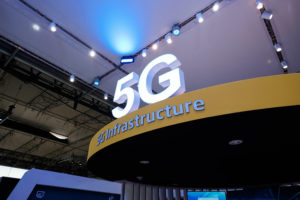The Pentagon on Thursday announced it has awarded $600 million in contracts for 5G pilot programs at five installations, which the department said represent “the largest full-scale 5G tests for dual-use applications in the world.”
The five projects include experimentation with smart warehouses at Marine Corps Logistics Base-Albany in Georgia and Naval Base San Diego, augmented and virtual reality at Joint Base Lewis-McChord in Washington, dynamic spectrum sharing at Hill AFB in Utah and distributed command and control at Nellis Air Force Base in Nevada.
“Through these test sites, the Department is leveraging its unique authorities to pursue bold innovation at a scale and scope unmatched anywhere else in the world. Importantly, today’s announcement demonstrates the Department’s commitment to exploring the vast potential applications and dual-use opportunities that can be built upon next-generation networks,” Michael Kratsios, acting under secretary of defense for research and engineering, said in a statement.
The smart warehousing project at Marine Corps Logistics Base Albany will focus on vehicles, and included awards to Federated Wireless to provide the 5G testbed, GE [GE] for modeling and analytics, KPMG to create a digitalized process for moving equipment and Scientific Research Corporation to demonstrate automated management of warehouse logistics.
“This project will develop a 5G-enabled Smart Warehouse focused on vehicular storage and maintenance, to increase the efficiency and fidelity of MCLB Albany logistic operations, including identification, recording, organization, storage, retrieval, and inventory control of materiel and supplies,” the department wrote.
At Naval Base San Diego, the smart warehouse project will focus on transshipment and includes awards to AT&T [T] for a rapidly deployed network, GE for 5G-enabled applications, Vectrus for a suite of applications and Deloitte for applications to support autonomous capabilities.
“The objective of this project is to develop a 5G-enabled Smart Warehouse focused on transshipment between shore facilities and naval units, to increase the efficiency and fidelity of naval logistic operations, including identification, recording, organization, storage, retrieval, and transportation of materiel and supplies,” the department wrote.
The augmented and virtual reality program at Joint Base Lewis-McChord includes awards to GBL for its Samsung [ADR]-based 5G testbed, AT&T to develop a system for 5G connectivity with current training devices, Oceus Networks to provide 5G-enabled handheld devices and Booz Allen Hamilton [BAH] to “deliver an Army-owned, multivendor prototype for combat-like training using AR/VR technology.”
“The objective of this project is to rapidly field a scalable, resilient, and secure 5G network to provide a test bed for experimentation with a 5G-enabled Augmented Reality/Virtual Reality (AR/VR) capability for mission planning, distributed training, and operational use,” the department wrote.
Vendors selected for the dynamic spectrum sharing effort at Hill Air Force Base include Nokia to deliver the 5G testbed, General Dynamics Mission Systems [GD] to field a new application to support the radio access network, Booz Allen Hamilton for an AI-enabled application, Key Bridge Wireless to demonstrate adaptation of existing commercial spectrum, Shared Spectrum Company to work on maintaining continuous 5G connections and Ericsson for sensing capabilities.
“This project addresses the challenge of enabling Air Force radars to dynamically share spectrum with 5G cellular services. The project will develop sharing/coexistence system prototypes and evaluate their effectiveness with real-world, at-scale networks in controlled environments. The objective of this effort is to develop effective methodologies to allow the sharing or coexistence between airborne radar systems and 5G cellular telephony systems in the 3.1 – 3.45 GHz band,” the department wrote.
Lastly, the sole commercial partner working on the distributed C2 project at Nellis Air Force base is AT&T, which will provide “an initially fixed then mobile 5G environment with high capacity and low latency to support the connectivity requirements associated with the mobile combined air operations centers.”
“The objective of this effort is to develop a testbed for use of 5G technologies to aid in Air, Space, and Cyberspace lethality while enhancing command and control (C2) survivability. Specifically, a 5G network will be employed to disaggregate and mobilize the existing C2 architectures in an agile combat employment scenario,” the department wrote.